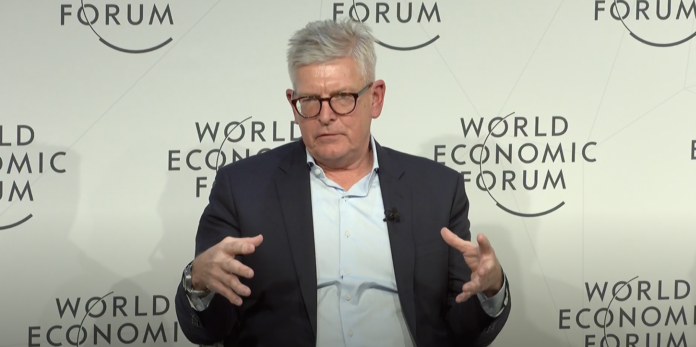The killer app for 5G will come with further investment in digital infrastructure
In the tech-focused and even tech-adjacent sessions this week at the World Economic Forum Annual Meeting in Davos, Switzerland, leaders from the worlds of industry and government have touted the importance and inevitability of “digital transformation.” While there’s broader debate around that keyword, what it means, and if it really means anything, to the extent that WEF is a barometer, it’s a core consideration for how capital will be spent, how it will influence the global workforce, and what all that means for society and the economy.
Ericsson CEO Börje Ekholm, speaking on a panel titled “Big Bets for Digital Industries,” said, “What we see is to digitalize enterprises, we will need to have improved connectivity, and it cannot be all wire-based. If you’re rotating machineries, it’s simply not possible” with wired connections. “I do believe that we are going to see this but where we are right now, we are at the [proof of concept] stage…They’re not industrialized applications yet. And I think…maybe we can say it’s a bit slower than we had hoped for. But I think also these type of changes take some time.”
In the larger sweep of digital transformation of industries, Eckholm said of connectivity that it’s often overlooked and taken for granted. But, “We see enterprises will be digitalized based on 5G technology because anything that can go wireless will go wireless.” He pointed to Ericsson’s own factory in Lewisville, Texas, where 5G has been deployed to support the manufacturing of 5G equipment. “We see a massive improvement in productivity—almost twice the labor productivity” along with material reductions in power consumption and waste water creation.
“All of this requires one thing and that’s what I want to bring back to, and that is the digital infrastructure. We cannot digitalize industries, supply chains, companies, societies, unless we get digital infrastructure that’s high-performance, secure and reliable.”
Ekholm also repeated the characterization that Europe is “way behind” in the deployment of 5G because there’s not a clear return on cost of capital which stifles scope and pace of investment. He called out the United States, China, the Middle East and Northeast Asia as leading geographies. He contrasted the regulatory environment in lagging markets versus what’s happening in India which was late to deploy 5G but is moving fast with significant public/private collaboration via the Digital India program, for instance. He called the sub-continent “a well-kept secret…india will probably have the strongest digital infrastructure outside of China in six months. WIth the pace they are rolling out, they will be at the forefront…They have recognized we will not be there without the government.”
Alongside strategic, accretive investment in digital infrastructure, Eckholm also called out the need for concurrent investments in education and re-skilling, another place governments have a vital role to play. Government, he said, “plays a very important role in preparing people for the change which is developing the right skills, the right capabilities, and also how you interact in the new society.” He acknowledged the perennial fear (and reality) that technology will displace portions of the workforce. “But I’m convinced there are going to be more jobs in the future, different skills, different capabilities. We have always addressed those changes in the past. We tend to think about the challenges of transformation as something bad. It’s not. If you look at the planet, we’re better off as a planet today than we were 100 years ago. I think that’s going to happen again.”
Back to the role of 5G, Eckholm reflected on advancements made possible by 4G—specifically the rise of mobile video consumption, particularly short-form content like that delivered through Instagram and TikTok, and ride-hailing. In terms of the “killer application” for 5G, he said, “The reality is it will come once the infrastructure is there. The infrastructure is so critically important to get in place…We’re gonna evolve, we’re gonna change and we’re gonna adjust, but we need some investments. That’s what we need to recognize.”

